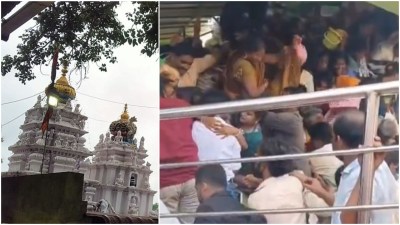Covet Thy Neighbours Wardrobe
The world is falling in love with the Pakistani suit.
The world is falling in love with the Pakistani suit.
One of the most delightful ironies of fashion is that a global wardrobe staple,the current favourite tunic-trouser combo,is derived from the East. From the Indian subcontinent to be precise. And instead of India with its immense textile and cultural history it is Pakistan whos trending this trend most vociferously.
The Pakistani suit,as it is affectionately called in north India,is essentially a salwar kameez thats derived from our neighbouring country. It has long fascinated the Indian woman for only one reason: it is rather fashionable. While Indian salwar kameezes are soaked in history and heritage (alternately in an overdose of Swarovski shimmers),the Pakistani cousin is high on innovation and also seasonal cycles.
My first hour in Lahore is spent at a ladies lunch at a swishy mall in Gulberg where the Pakistan Fashion Design Council (PFDC) had opened its mint-new multi-designer boutique. Nusrat Jamil,a 66-year-old beauty and cultural czarina,takes me around for a look-see. Like every other Indian woman,the Pakistani salwar kameez held mystery,mystique and allure for me. Enough to make me want to decipher the real McCoy.
How is it different from an Indian salwar,I ask Jamil. Its cut differently, she replies,showing me half a dozen different cuts all from one designer. Perhaps,its the lack of a varied wardrobe choice that demands constant innovation. Indians have several types of a national dress,each state comes with its own history and then there are assorted sari drapes. Pakistan only has the salwar kameez,its their uniform for men and women. Pakistanis are constantly updating their salwar-kameez,modernising it,glamourising it,deconstructing it and reconstructing it and finally turning it into something for a world traveller.
The tunic or the kaftan (long tunic) is a cross-country fashion perennial, says Hilary Alexander,former fashion director of UKs The Daily Telegraph. It could be from India,Pakistan,the Middle East,Morocco,it doesnt matter. If everyone doesnt have one,everyone wants one. Alexander is here as a guest of Sehyr Saigol,the publisher of the popular fashion magazine Libas,and the promoter of the PFDC Sunsilk Fashion Week. Alexander has been here before and has noted a sea-change in just two years. For the first time,the Karachi designers clique is here,overriding the great fashion divide that afflicts the country. Also,its the first time a New Talent show has been created where the focus is on digital prints,the au courant luxury prêt that aims to drive the business.
This being the subcontinent,bling is still king. Among a sea of high-end couture pieces,mostly bridal outfits or jodas,emblazoned with embroidery in gold,pearls and beads,is the newest craze for the kaleidoscopic digitised print. It doesnt require expensive hand-made techniques,you dont have to store it for a generation,its relatively cheap and appropriately modish.
Sania Maskatiyas label is less than three years old,but she has quickly become a favourite with the young locals and the fashionable non-residents. She mixes block and screen printing with computerised graphics and machine embroidery,sometimes all in one outfit,and yet makes it work together. She gives her silken flowing tops asymmetrical hemlines (longer at the back) and teams them with narrow trousers or leggings.
Lawn fashion is quite the ready-to-wear rage here too. Lawn,means a cotton voile,thats absolutely summer-friendly. It is Indias answer to mul,or the Italians to linen,but I dont see many Indian designers getting more climate-specific than a coarse khadi. Ittehad is a lawn textile magnate that ironically has Priyanka Chopra on its campaigns.
Somal Halepoto also celebrates Pakistans love of prints. She uses gold block printing on pastel shades,puts her tunics on three-quarter pants and marries pyjamas with shirts and a sheer coat. Feesha Jamshed rides the B&W chequered and stripes wave wonderfully. Nida Azwer plays it commercial and safe and teams her cowl-laden blouses with palazzo pants.
Of course,there are those who play to the gallery with eyeballs strained on western departmental stores. Rizwan Beygs truck art inspired line has vivid kitsch motifs in faux leather whites: pants,boleros,boots and accessories. Im going to Harvey Nichols and Sao Paolo, he says when I meet him after his show. Fahad Huseyn showed some edge with headdresses borrowed from a taxidermist.
Sana and Safinaz are sisters-in-law whose clothes are as polished and red-carpet worthy as they can get. HSY is another popular label that skips prints for delightful embroideries. Hasan Sheheryar Yasin’s short tunic with short leggings turns out to be a lot of fun.
Pakistani fashion is hard to get in India,but not impossible. Trunk shows have been around for a while,and the clothes are often sourced from Dubai malls. Imrana Khera is a Pakistani-origin American who now lives in Mumbai. Shes hosted two successful trunk shows here called The Grand Trunk Road. I decided to host them because every time I wore a Pakistani suit,I would get asked about it, she says. I brought mostly occasion-wear,but the casual pieces are very distinct too theyre fresh and modern,and can be clubbed with resort fashion.
Pradeep Hirani,who owns Kimaya and Karmik stores in several metros,says Pakistani clothes are hard to import because of duties levied. They add up to almost 40 per cent,and its hard to make money from them,even though the demand may be huge, he says.
The PFDC opened its first eponymous boutique in New Delhis South Extension II only in September 2012. It is run by an Indian textile businesswoman,Mini Bindra,who I also meet in Lahore. Pakistani fashion is a fusion of Indian and contemporary, she says. Beyond a point,the Indian salwar kameez is dated. Pakistani ghararas,izars and lawns are very popular. The stores success has led Bindra to plan more stores in Punjab.
Chhavi Seth Mediratta is a London-based Indian who plans on launching an online store only for fashion from India and Pakistan. She says the expatriate-strong UK is a market thats waiting to be broken into. But the modern Pakistani suit seems to belong to the world.



- 01
- 02
- 03
- 04
- 05




























